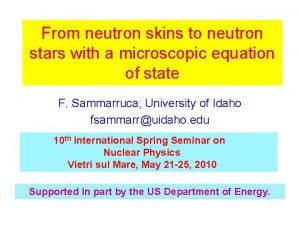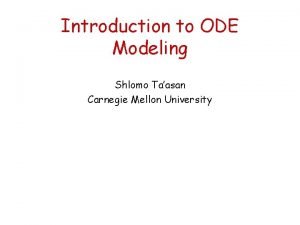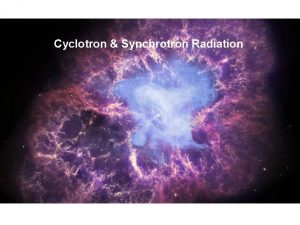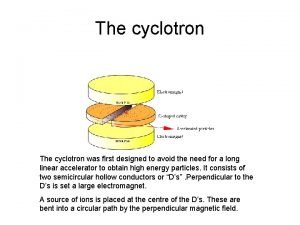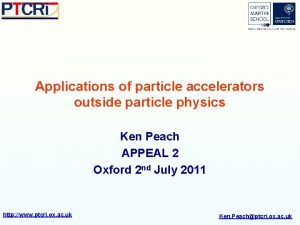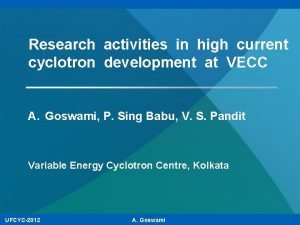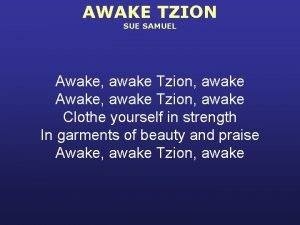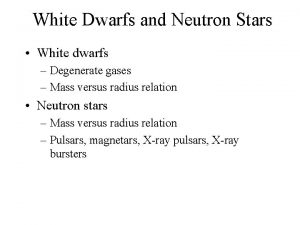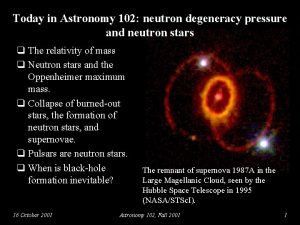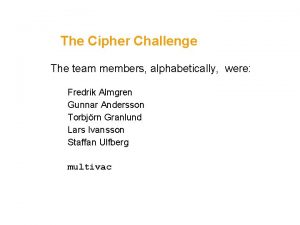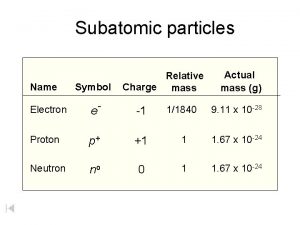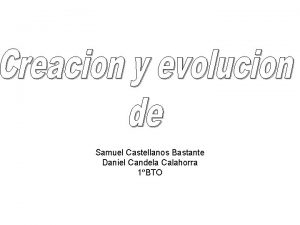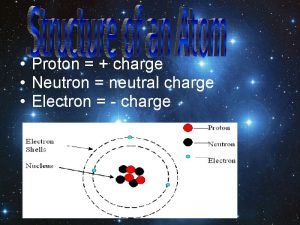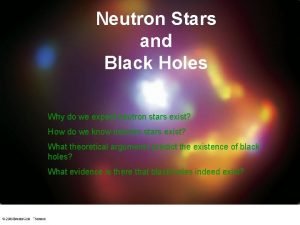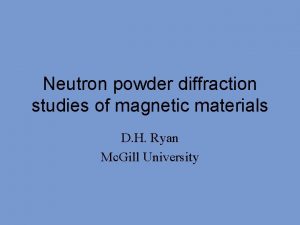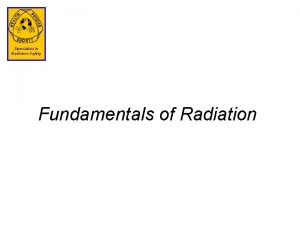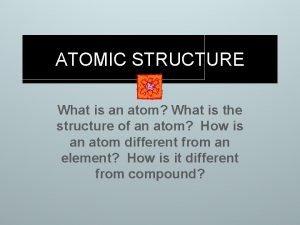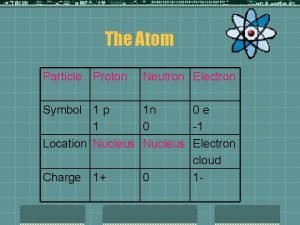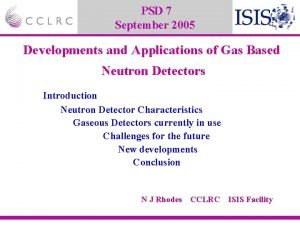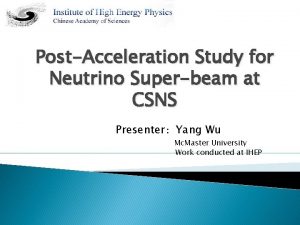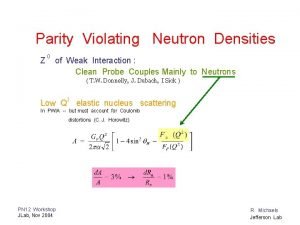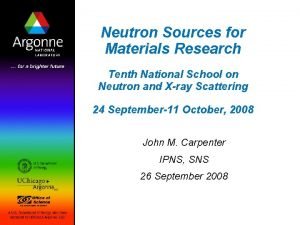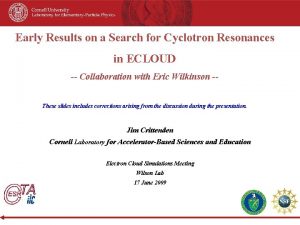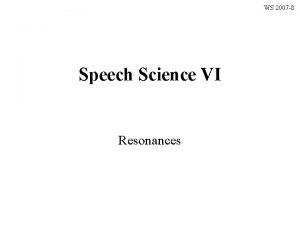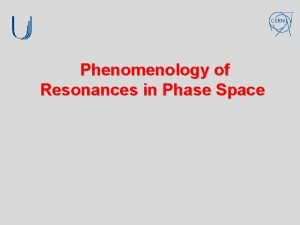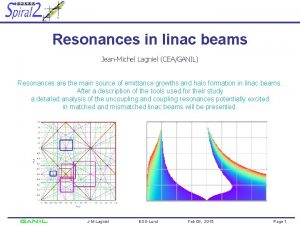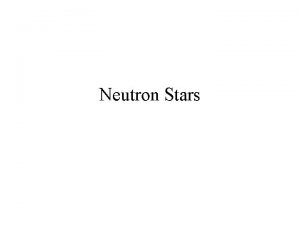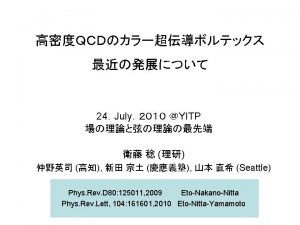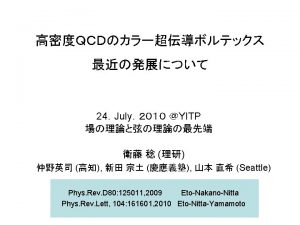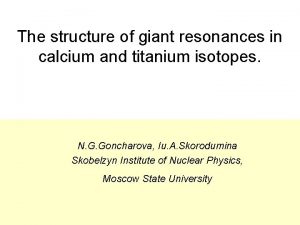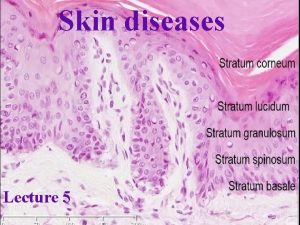NEUTRON SKIN AND GIANT RESONANCES Shalom Shlomo Cyclotron

















































- Slides: 49

NEUTRON SKIN AND GIANT RESONANCES Shalom Shlomo Cyclotron Institute Texas A&M University

Outline 1. Introduction Isovector giant dipole resonance, Giant resonances (GR) and bulk properties of nuclei 2. Experimental and theoretical approaches for GR Hadron excitation of giant resonances Hartree-Fock plus Random Phase Approximation (RPA) 3. Density dependence of symmetry energy and neutron skin A study within the Energy Density Functional Approach (EDF) 4. Giant resonances and symmetry energy density ISGMR—Incompressibility and Symmetry energy IVGDR and ISGMR in Ca isotopes 5. Nuclear + Coulomb excitations of GR and neutron skin 6. Conclusions

The isovector giant dipole resonance The total photoabsorption cross-section for 197 Au, illustrating the absorption of photons on a giant resonating electric dipole state. The solid curve show a Breit-Wigner shape. (Bohr and Mottelson, Nuclear Structure, vol. 2, 1975).

Macroscopic picture of giant resonances L=0 L=1 L=2

Hadron excitation of giant resonances Ψf χf VαN α χi Nucleus Ψi Theorists: calculate transition strength S(E) within HF-RPA using a simple scattering operator F ~ r. LYLM: Experimentalists: calculate Approximation (DWBA): cross sections or using folding model. within Distorted Wave Born

DWBA-Folding model description

Hartree-Fock with Skyrme interaction For the nucleon-nucleon interaction we adopt the standard Skyrme type interaction are 10 Skyrme parameters.

Carry out the minimization of energy, we obtain the HF equations:


Hartree-Fock (HF) - Random Phase Approximation (RPA) In fully self-consistent calculations: 1) Assume a form of Skyrme interaction ( - type). 2) Carry out HF calculations for ground states and determine the Skyrme parameters by a fit to binding energies and radii. 3) Determine the particle-hole interaction, 4) Carry out RPA calculations of the strength function, transition density, etc.

Giant Resonance In the Green’s Function formulation of RPA, one starts with the RPAGreen’s function which is given by where Vph is the particle-hole interaction and the free particle-hole Green’s function is defined as where φi is the single-particle wave function, єi is the single-particle energy, and ho is the single-particle Hamiltonian.

We use the scattering operator F obtain the strength function and the transition density. is consistent with the strength in

Density dependence of symmetry energy and Neutron skin within EDF E. Friedman and S. Shlomo, Z. Phyzik, A 283, 67 (1977) The energy density functional is decomposed as Where ρn and ρp are the density distributions of neutrons and protons respectively, and

For the Coulomb energy density, εc, one usually uses the form where the first term is the direct Coulomb term with Vc(r) given by

For the symmetry energy density, εsym, we assume the form The interaction V 1(r) is taken to be of the form where ρm(r) is the nuclear matter density distribution, ρ0=0. 165 fm-3. In accordance with the semiemperical mass formula we impose the constraint The terms with a 2, a 3, and a 4 have been used previously in nuclear matter calculations and in applications of the EDF to finite nuclei.

Considering now the constraint We introduce a Lagrange multiplier λ and minimize using δρm=δρp+δρn=0.

We obtain with where Vc(r) and V 1(r) are given by previous equations.

The EDF is not known for low density. Thus the variational equation for ρ1(r) must be used only in an internal region r<RM where RM is a prescribed matching radius. For r > RM the resulting ρn(r) and ρp(r) should be positive and decay exponentially with r. Taking RM=R, then for the internal region, r < R, we have where,

For the external region, r > R, we choose where the coefficients C and γ are determined by imposing (i) the continuity of the densities and (ii) the total normalizations A surface enhancement parameter y is defined by

Values of rn-rp Parameterization calculations have been made for 48 Ca and 208 Pb using a parabolic Fermi for the proton distribution, with c=3. 74 fm, a=0. 53 fm and ω=-0. 03, leading to rp = 3. 482 fm for 48 Ca, and c=6. 66 fm, a=0. 50 fm and ω=0 leading to rp = 5. 483 fm for 208 Pb




Giant Resonances and Symmetry Energy ISGMR --Incompressibility and symmetry energy ISGMR in Ca isotopes IVGDR in Ca isotopes and symmetry energy

40. 00 35. 00 Sym. Energy 30. 00 SGII SKMS 25. 00 KDE 0 Sly 4 20. 00 Sly 5 Sly 6 Sk. I 4 15. 00 Sk. I 5 SK 255 10. 00 5. 00 0. 0000 0. 0500 0. 1000 Density 0. 1500

Fully self-consistent HF-RPA results for ISGMR centroid energy (in Me. V) with the Skyrme interaction SK 255, SGII and KDE 0 and compared with the RRPA results using the NL 3 interaction. Note the coressponding values of the nuclear matter incompressibility, K, and the symmetry energy , J, coefficients. ω1 -ω2 is the range of excitation energy. The experimental data are from TAMU. Nucleus ω1 -ω2 90 Zr 0 -60 10 -35 116 Sn 208 Pb SGII KDE 0 18. 7 18. 9 17. 9 18. 0 17. 3 16. 4 16. 6 16. 2 15. 3 15. 5 16. 2 15. 5 14. 3 13. 6 13. 8 14. 4 13. 6 13. 8 15. 85± 0. 20 16. 1 15. 40± 0. 40 0 -60 10 -35 SK 255 17. 1 0 -60 10 -35 NL 3 17. 81± 0. 30 0 -60 10 -35 144 Sm Expt. 14. 2 13. 96± 0. 30 K (Me. V) 272 255 215 229 J (Me. V) 37. 4 26. 8 33. 0






Nuclear and Coulomb Excitations of Giant Resonances Neutron skin and nuclear excitation of IVGDR by alpha (T=0) scattering Interference between Nuclear and Coulomb excitations of GR and neutron skin

Definitions: Assuming uniform density distributions For:

For Isovector Dipole (T=1, L=1) oscillations; Co. M: g = -Z/A for a neutron and N/A for a proton. Transition density and transition potential are:

For a proton projectile the transition potential is: With Note: Un and Up are of different geometry

And Expanding the ground state densities: Where,

We obtain for a proton projrectile

For excitaion of IVGDR by a proton: With

For excitaion of IVGDR by an alpha particle (T=0), adding the contributions of the two neutron and two protons, we have Note that;

For excitaion of ISGMR by an alpha particle;







CONCLUSIONS 1. Fully self-consistent HF-based RPA calculations of the ISGMR lead to K = 210 -250 Me. V with uncertainty due to the uncertaint in the symetry energy density. 2. The neutron skin depends strongly on the density dependence of the symmetry energy. 3. The dependence of the centroid energy of the Isovector giant dipole resonance is clouded by the effects of (i) momentum dependence of the interaction (ii) the spin-orbit interaction. 4. Interference between Nuclear and Coulomb excitations of GR can be used to determine the depependence of neutron skin on N-Z. 5. Accurate determination of the magnitude of the neutron skin in neutron rich nuclei is very much need.


 Neutron skin
Neutron skin Shlomo ta'asan
Shlomo ta'asan Shlomo hershkop
Shlomo hershkop Shlomo kramer
Shlomo kramer Shlomo hershkop
Shlomo hershkop Thick skin
Thick skin Cyclotron and synchrotron radiation
Cyclotron and synchrotron radiation Thin skin vs thick skin
Thin skin vs thick skin Chapter 23 milady
Chapter 23 milady Cyclotron formulas
Cyclotron formulas Cyclotron
Cyclotron Cmgi uc davis
Cmgi uc davis Baby cyclotron
Baby cyclotron Cyclotron
Cyclotron Cyclotron diagram
Cyclotron diagram Antaya science and technology
Antaya science and technology Yahweh shalom altar
Yahweh shalom altar Liceo nacional shalom sincelejo
Liceo nacional shalom sincelejo Shiloh shalom
Shiloh shalom Define shalom aleichem
Define shalom aleichem Shalom ma shlomcha
Shalom ma shlomcha Shalom adonai zagreb
Shalom adonai zagreb Shabbat shalom shofar
Shabbat shalom shofar Shalom h. schwartz
Shalom h. schwartz Yaseh shalom
Yaseh shalom Shalom life foundation
Shalom life foundation Shabbat shalom中文
Shabbat shalom中文 Shalom berakhah ve-tovah
Shalom berakhah ve-tovah Joseph albo
Joseph albo Yaase shalom
Yaase shalom Shalom junior school
Shalom junior school Carlton comprehensive high school math
Carlton comprehensive high school math Isis neutron and muon source
Isis neutron and muon source Neutron degeneracy pressure
Neutron degeneracy pressure Neutron degeneracy pressure
Neutron degeneracy pressure Cipher neutron
Cipher neutron Name of symbol
Name of symbol Candela y neutron
Candela y neutron Electron charge
Electron charge Neutron star
Neutron star 642008419
642008419 Find the number of neutrons h
Find the number of neutrons h Beta decay
Beta decay Neutron degeneracy pressure
Neutron degeneracy pressure Mass of neutron
Mass of neutron Symbol proton neutron elektron
Symbol proton neutron elektron Spallation neutron source
Spallation neutron source Spallation neutron source
Spallation neutron source Parity of neutron
Parity of neutron Spallation neutron source
Spallation neutron source
